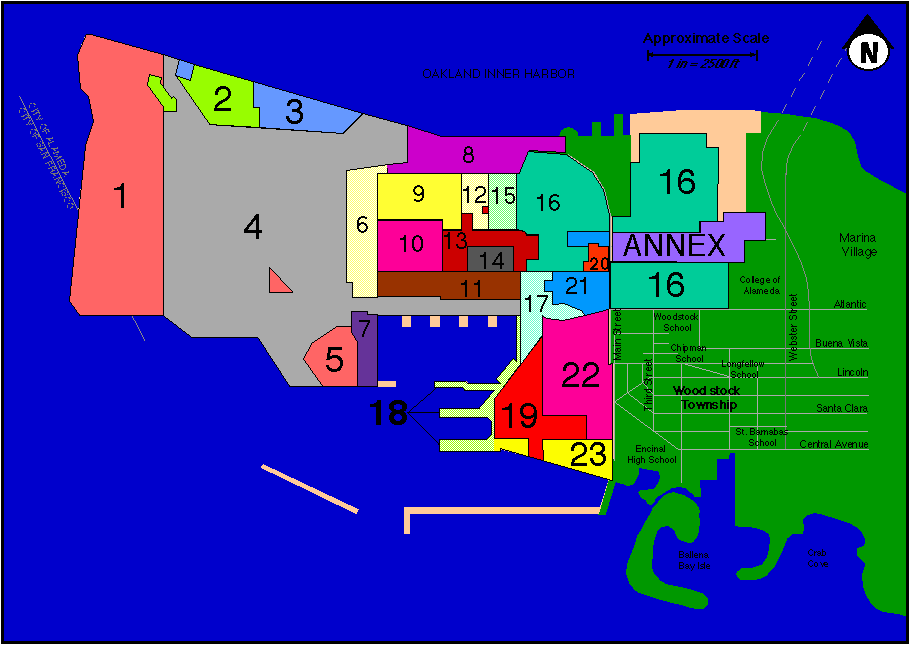NAS Land Use Zones

|
|

Environmental Baseline Survey (EBS) Database
This EBS database contains summary information collected by the Navy during the ongoing fence-line to fence-line environmental assessment of Alameda Point. The property at Alameda Point has been categorized into 23 zones consisting of 214 separate parcels.Summaries of EBS information can be reviewed by clicking on an area of the map above or the table below.
|
Parcel P121-40 | Parcel P141-60 | Parcel P161-80 | Parcel P181-200 | Parcel P201-14 | |
EBS Process
- CERFA Qualification - Properties with no record of spills, hazardous material storage or potential for contaminants to migrate onto the parcel where CERFA Qualified. CERFA parcelswere not evaluated further under the Environmental Baseline Survey Program. Six of the 214 parcels at Alameda Point were CERFA Qualified. The remaining 208 parcels were initially classified as BRAC7 - Further Evaluation Necessary
- Phase One - A paper search was performed. Historical information was collected on hazardous material spills and previous hazardous material storage at each of the BRAC7 parcels. Based on this Phase One evaluation many parcels were reclassified into different BRAC categories that made them eligible for transfer. When further information was deemed necessary for BRAC classification, areas on the parcel were targeted for Phase 2A sampling.
- Phase 2A - Sampling of soil and soil gas for hazardous material spill residues was performed. If sample results indicated the presence of high concentrations of toxins, or further information was deemed necessary for BRAC classification, Phase 2B sampling was recommended. If detectable concentrations of a chemical of concern were encountered the results were used in the Tiered Human Health Risk Screening Program.
- Phase 2B - Sampling of soil, soil gas, and groundwater was performed to confirm the results of Phase 2A sampling and to better determine the aerial extent of contamination. Results of Phase 2A/2B sampling were used in the Tiered Human Health Risk Screening Program.
Tiered Human Health Risk Screening Program
- Tier 0 Risk Screening - Risk screening was not performed on CERFA parcels, and BRAC1 parcels because no evidence of hazardous material spills were found at these sites. No risk screening was performed on BRAC2 parcels where only petroleum spills were found, despite the Navy having developed Tier 1 Risk Screening levels for petroleum compounds specifically for use at Alameda Point.
- Tier 1 Risk Screening - Chemical analyses results of soil and groundwater samples were compare to US EPA Region IX Preliminary Remediation Goals. The Region IX PRGs are a table of safe spill residue concentrations at a typical Superfund site. If comparison of the Phase 2A/2B sample results indicated that PRGs were exceeded a more complete Tier 2 Risk Screening was performed.
- Tier 2 Risk Screening - This risk screening used site specific exposure scenarios based on property use (residential, recreational, industrial). The differences between the Navy and Cal-EPA's methodologies for estimating human health risk are the center of an ongoing dispute that continues to delay property cleanup.
Human Health Risk Estimates
- Cancer Risk - Generally associated with long-term exposure to low doses of a toxin. The risk is stated as the number of additional cancer cases that a certain level of exposure will cause in a population of one million people. A risk of one in a million, 0.000001 or 10-6, is considered acceptable. Cal-EPA and US EPA have both established cancer risks of 10-6 as being the desired cleanup level. Generally cancer risks in excess of 10-6 remaining on a property will result in deed restrictions including restrictions on property use. A cancer rate of 100 cases of cancer per one million people, 10-4 is the maximum risk allowed under Superfund cleanup regulations. The Navy has established this maximum risk of 10-4 as their cleanup objective.
- Non-Cancer Risk - Generally associated with short-term exposure to high doses of a toxin. The risk is stated in terms of a hazard index. A hazard index equal to one or greater is considered always unsafe.
Cancer Risk Additional Cancer Case in Exposed Population Cal-EPA and US EPA Requirements less than 10-6 No action required. 10-6 1 in 1,000,000 Deed restrictions required. 10-5 10 in 1,000,000 Proposition 65 notifications required. greater than 10-4 100 in 1,000,000 Spill cleanup required. Non-Cancer Hazard Index less than 1.0 No action required. greater than 1.0 Spill cleanup required.
Assignment of BRAC Category
- Assignment of BRAC Category - One of seven categories to describe environmental condition of property and suitability to transfer. The following categories exist:
CATEGORY DESCRIPTION FINDING OF SUITABILITY TO TRANSFER BRAC7 Additional evaluation required. No Transfer BRAC6 Cleanup of hazardous material spill required to reduce cancer risk below 10-4 or Hazard Index below 1.0. No Transfer BRAC5 BRAC6 Site is reclassified when cleanup plan has been successfully initiated. Dirty Transfer BRAC4 BRAC5 Site is reclassified to BRAC4 when the cleanup plan has been completed. Transfer Okay BRAC3 Evidence of a hazardous material spill. Below tiered screening levels of Cancer Risk = 10-4 and Hazard Index = 1.0. Transfer Okay BRAC2 Evidence of a petroleum spill only. Below tiered screening levels of Cancer Risk = 10-4 and Hazard Index = 1.0. Transfer Okay BRAC1 No evidence of a hazardous material spill. Transfer Okay CERFA No records of hazardous material storage or activity. Transfer Okay
|
|